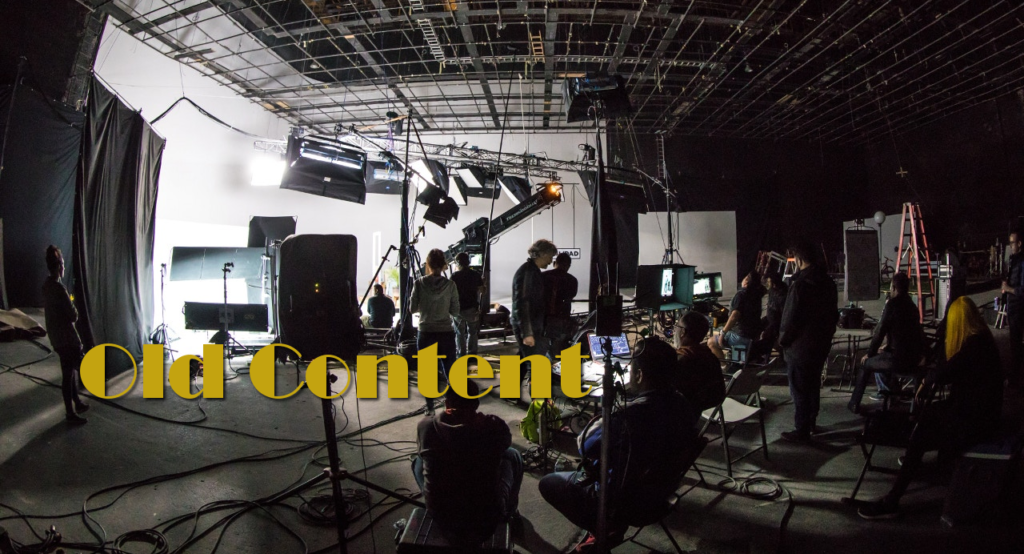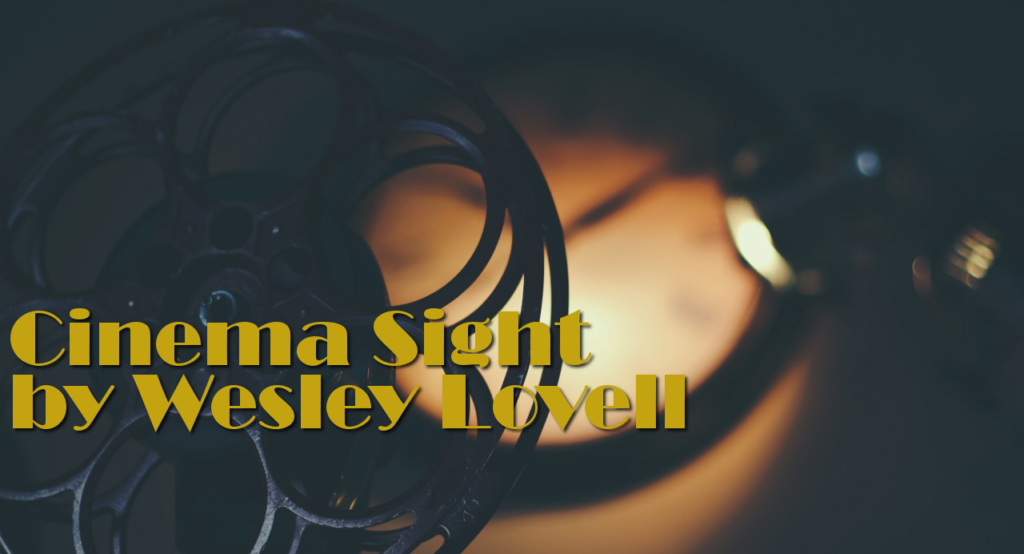
Back in September, I mentioned With a Song in My Heart and I’ll Cry Tomorrow as part of my report on movie musicals from 1927 through 1955. Both, starring Susan Hayward, are finally being released on DVD. I’ll Cry Tomorrow, the musical biography of Lillian Roth, releases today as part of Warner Bros’. Leading Ladies Collection Volume 2 along with A Big Hand for the Little Lady (Joanne Woodward), Rich and Famous (Jacqueline Bisset and Candice Bergen), Shoot the Moon (Diane Keaton) and Up the Down Staircase (Sandy Dennis). With a Song in My Heart, the musical biography of Jane Froman,releases next week.
1955, as I mentioned in the September report, was the year the presentation of the movie musical changed. In order to lure TV watchers out of their homes and into theatres, movies were becoming bigger and more spectacular, and what could be more spectacular than big screen versions of Broadway mega-hits?
Tentative steps toward the bigger and better began with the 1954 Cinemascope presentations of such original screen musicals as There’s No Business Like Show Business, Seven Brides for Seven Brothers and A Star Is Born and the VistaVision presentation of White Christmas, as well as more modern Cinemascope remakes of old standbys such as Rose Marie and The Student Prince, but it was 1955’s Oklahoma! that really raised the bar.
Oklahoma! was filmed in Todd-A-O, an ultra wide screen process that not all theatres were capable of presenting. Consequently, it was also filmed in Cinemascope, the separate processes requiring actors and crews to shoot the film twice.
The highly anticipatedfilm was the first of Rodgers & Hammerstein Broadway musicals to reach the screen. Presented as an event, the film seen today seems a bit clunky – it’s too long and stage-bound – but audiences of the day ate it up.
Fox’s 50th Anniversary Edition DVD, which is also part of the Rodgers & Hammerstein Collection, features both the Todd-A-O and Cinemascope versions. The Cinemascope version, filmed with a 35 mm camera is the clearer, easier to watch version than the Todd-A-O which was filmed in 70 mm.
The highlight of the film is the score, which includes “Kansas City”, “The Surrey With the Fringe on the Top”, “People Will Say We’re in Love” and the rousing title song. All are given spectacular presentations and are well sung by Gordon MacRae, Shirley Jones, Gene Nelson, Gloria Grahame, Eddie Albert and Charlotte Greenwood.
Another hit musical of 1955 was Guys and Dolls, which was also given the lavish Cinemascope treatment and a cast of superstars including Marlon Brando, Jean Simmons, Frank Sinatra, and repeating her sensational Broadway triumph, Vivian Blaine. Brando actually does quite well for a non-singer, but the obviously stylized sets keep reminding us that we are watching a filmed version of a stage show rather than a full bodied movie. Again, the highlight is the score and “If I were a Bell”, “Luck Be a Lady” and the rest are all given their due.
As if one Rodgers & Hammerstein per year wasn’t enough, Fox gave us two in 1956, Carousel and The King and I.
The film version of Carousel was treated shabbily by Fox from the get-go. The look of the film is rather dull, and in fact, prints faded so fast that by 1960 the film was virtually unwatchable until it was restored for laserdisc in the 1990s. To add insult to injury, Fox executives were concerned that the film ran too long and cut out two of the film’s best sequences, featuring the songs “You’re a Queer One, Julie Jordan” and “Blow High, Blow Low”. The music, though, is once again the highlight, with Gordon MacRae and Shirley Jones leading the cast. The score includes “If I Loved You” and “You’ll Never Walk Alone”.
The King and I, on the other hand, was given the royal treatment by Fox. Released as Fox’s prestige film that year, it was nominated for 9 Oscars including Best Picture, Actor (Yul Brynner repeating his Tony award-winning role as the King of Siam), Actress (Deborah Kerr) and Director (Walter Lang). It won five including Best Actor.
The King and I was the first of the Rodgers & Hammerstein musicals in which the story was given as much importance as the music. It had, in fact, been successfully filmed ten years earlier as a straight drama by Fox, called Anna and the King of Siam with Irene Dunne and Rex Harrison. Audiences of the day expected the musical version to be no less thrilling than the original. They were not disappointed. Among the songs moving the story forward are “Getting to Know You”, “Hello Young Lovers” and “Shall We Dance?”
I talked about the films of 1957 in an August report, including the year’s four hit musicals, Funny Face, The Pajama Game, Silk Stockings and Les Girls, and won’t dwell on them here.
By 1958 Broadway to Hollywood transfers were practically guaranteed to make money and all three of that year’s major musicals did so in spades.
The film version of Rodgers & Hammerstein’s South Pacific was well cast with Mitzi Gaynor, Rossano Brazzi, John Kerr, France Nuyen, Ray Walston, Juanita Hall and others, most of whom could sing, though some such as Hall, Broadway’s original Bloody Mary, were dubbed anyway. Fox wanted the best voices coming out of the best physical representations of the beloved characters. The film’s only flaw is the pinheaded acquiescence to director Joshua Logan’s idea of presenting numerous song sequences in changing hues that obscure the beauty of the scenery. The great score includes “There Is Nothing Like a Dame”, “Younger Than Springtime”, “Some Enchanted Evening” and “I’m Gonna Wash That Man Right Out of My Hair”.
Tab Hunter, who received top billing in Adler and Ross’ Damn Yankees was the only member of the cast not in the original Broadway production. While he acquits himself quite well, he is no match for either Ray Walston as the Devil or Gwen Verdon as the Devil’s helper, Lola. The immortal score includes “Whatever Lola Wants (Lola Gets)” and “(You’ve Gotta Have) Heart”.
The year’s crowing achievement was the sophisticated Gigi, an original screen musical from the composers of Broadway’s then-most-successful musical, My Fair Lady. Itwas nominated for nine Oscars and waltzed away with all of them including Best Picture and Director (Vincente Minnelli). Though none of the actors were nominated, Maurice Chevalier was given an honorary award “for his contributions to the world of entertainment for more than half a century.” Leslie Caron, Louis Jourdan and Hermione Gingold also bring their considerable charm to the film which includes such delightful tunes as “I’m Glad I’m Not Young Anymore”, “The Night They Invented Champagne”, “Thank Heaven for Little Girls” and the Oscar winning title song.
Two years later Minnelli directed Judy Holliday in a reprise of her Tony Award-winning role in the Jule Styne-Betty Comden-Adolph Green musical, Bells Are Ringing, where once again the songs were the highlight. They included “Just in Time”, “I’m Going Back” and “The Party’s Over”.
A mere three years after Gigi‘s triumph, West Side Story was nominated for 11 Oscars and won 10. Warner Bros.’ Collectors Set DVD is a treasure trove befitting the film’s place as the most awarded musical of all time. It includes a booklet featuring Ernest Lehman’s complete screenplay as well as a vivid transfer of the film and numerous documentaries. Natalie Wood and Richard Beymer were not singers, but their voices were seamlessly dubbed. Among the film’s ten Oscars were those for Best Picture, Director (Robert Wise and Jerome Robbins), Best Supporting Actor (George Chakiris) and Best Supporting Actress (Rita Moreno). The film’s score by Leonard Bernstein and Stephen Sondheim, includes “Maria”, “Tonight” and “Somewhere”.
Considered somewhat of a lesser Rodgers & Hammerstein musical, Flower Drum Song is the only one of their Broadway-to-Hollywood transfers that was not produced by Twentieth Century-Fox. Universal finally released a DVD version last November filled with bells and whistles belying its long-held lowly status. Stars Nancy Kwan and James Shigeta provide insightful commentary including speculation on the disappearance of co-star Miysohi Umeki whose whereabouts were divulged only after she died this August. The delightful Juanita Hall and Benson Fong co-star. The score includes “A Hundred Million Miracles”, “Chop Suey” and “I Enjoy Being a Girl”.
One of the most popular Broadway musicals of all time was Meredith Willson’s The Music Man. The 1962 film version proved just as popular, garnering six Oscar nominations and winning one for adapted score. Robert Preston reprised his Tony Award-winning role as Professor Harold Hill to great acclaim and Shirley Jones successfully replaced Broadway’s Barbara Cook as Marian the Librarian. Young Ronny Howard is her little brother. The rich score includes “76 Trombones”, “Till There Was You” and “Gary, Indiana”. The bells and whistles DVD includes an introduction by Jones.
An even more enduring stage musical is Jule Styne and Stephen Sondheim’s Gypsy. The original Broadway version was a highlight of Ethel Merman’s career and subsequent versions with Angela Lansbury, Tyne Daly and Bernadette Peters proved equally popular. There was even a 1993 TV production with Bette Midler. The 1962 film version got a bum rap from the get go as partisans of Miss Merman spread rumors before the film was even released that Rosalind Russell’s singing was a joke and her performance inept. Actually her performance is quite good and her singing voice is blended with that of Lisa Kirk obscuring any deficiency in that department. Russell won her fifth Golden Globe as Best Actress, her third in a Musical or Comedy, and the film itself was nominated for three Oscars. Natalie Wood and Karl Malden co-star. The immortal score includes “Everything Is Coming Up Roses”, “Let Me Entertain You” and “Rose’s Turn” which Russell performs in spectacular fashion.
Ann-Margret burst onto the scene as Bette Davis’ convent-educated daughter in Pocketful of Miracles but audiences really took note of her at the 1961 Oscars in March of 1962 when she sang the nominated title song from Bachelor in Paradise in provocative fashion. She had a starring role later that year in the remake of Rodgers & Hammerstein’s State Fair opposite Pat Boone, but was relegated to playing the ingénue in the film version of Strouse and Adams’ Bye Bye Birdie. To take advantage of her status as Hollywood’s newest sex symbol, Columbia had the composers come up with a new title song which they then had Annie perform at the opening and end of the film provocatively, reminiscent of her Oscar appearance that had nothing to do with her character in the film. Though the film was an all-around success, that opening number is basically what people still remember about the film which stars Janet Leigh and Dick Van Dyke and includes such songs as “Put on a Happy Face” and “One Boy”.
1964 was a good year for movie musicals. Ann-Margret teamed with Elvis in Viva Las Vegas,The Beatles proved charming naturalistic actors playing themselves in A Hard Day’s Night and Debbie Reynolds won a richly deserved Oscar nomination for Meredith Willson’s The Unsinkable Molly Brown, but the most anticipated musical that year was Lerner & Loewe’s My Fair Lady.
Jack Warner’s dream cast for his pet project film version of My Fair Lady included Cary Grant as Henry Higgins, Audrey Hepburn as Eliza Doolittle and James Cagney as Alfred Doolittle. He got Hepburn, but Cagney declined and Grant went a step further, telling the producer that not only would he not play Higgins, but if anyone other than Rex Harrison played the part he wouldn’t go to see it. Warner took Grant’s advice and cast Harrison as well as veteran character actor Stanley Holloway who originated the role of Eliza’s father in the Broadway production. Gladys Cooper replaced Broadway’s Cathleen Nesbitt as Harrison’s mother, overtime on the film necessitating her dropping out of the screen version of her own Broadway triumph, The Chalk Garden, in which she was replaced by Edith Evans who played the part in London.
Both Evans and Cooper were nominated for Supporting Actress Oscars. My Fair Lady was nominated for a total of 12 Oscars, including Best Picture, Director (George Cukor), Actor (Harrison) and Supporting Actor (Holloway). It won 8 including Best Picture, Director and Actor. Ironically, the film’s biggest draw, Hepburn, wasn’t even nominated. Julie Andrews, who Warner snubbed for having no film experience, won for her performance in the year’s other big hit musical, Mary Poppins.
Disney’s most honored film, Mary Poppins beat My Fair Lady by one nomination, garnering 13 nods, eventually winning five. Dick Van Dyke, Glynis Johns, David Tomlinson, Elsa Lanchester, Hermione Baddeley and Jane Darwell were among the players surrounding Andrews as the perfect nanny. The score includes “A Spoonful of Sugar”, “Feed the Birds” and the Oscar winning “Chim chim Cher-ee”.
Helping to secure Andrews’ Oscar was the release of The Sound of Music in which she also starred, during awards season. The most successful film of all time until Jaws came along ten years later, the last Rodgers & Hammerstein musical was also the last to hit the big screen. Andrews’ irresistible performance as the postulant nun-turned-governess-turned-wife and stepmother, the gorgeous cinematography and a score that included “My Favorite Things”, “Climb Ev’ry Mountain” and the title song were the chief reasons for its immediate, as well as its continuing, popularity. The film was nominated for ten Oscars including Best Picture, Director (Robert Wise), Actress (Andrews) and Supporting Actress (Peggy Wood). It won five including Best Picture and Director.
My Fair Lady, Mary Poppins and The Sound of Music have been released numerous times on home video, the most recent DVD editions of each being the most pristine. Avoid at all costs any VHS version of My Fair Lady as well as the first laserdisc pressing, all of which are quite hideous.
In the wake of these mega-hits came disappointing film versions of A Funny Thing Happened on the Way to the Forum, How to Succceed in Business Without Really Trying, Half a Sixpence and Camelot as well as a spate of lackluster original musicals such as Thoroughly Modcern Millie
e and Doctor Dolittle. The one interesting film musical released between The Sound of Music and Funny Girl and Oliver! four years later, was The Happiest Millionaire.
The last film personally supervised by Walt Disney, The Happiest Millionaire was based on a non-musical Broadway play about the early life of heiress Cordelia Biddle Duke. The film had an eclectic cast headed by Fred MacMurray, Tommy Steele, Greer Garson, Gladys Cooper, Geraldine Page, Lesley Ann Warren and John Davidson, and a score by the Sherman Brothers, the composers of Mary Poppins. Highlights of the score include “Fortuosity”, “We Are Dancing”, “I’ll Always Be Irish” and “There Are Those”, a counterpoint of waspish one-upmanship sung by Cooper and Page.
If Julie Andrews’ phenomenal success in Mary Poppins and The Sound of Music came as a surprise, the success of Barbra Streisand in Jule Styne and Bob Merrill’s Funny Girl was highly anticipated. She was, after all, reprising her portrayal of Fanny Brice in the film version of the highly successful Broadway musical. The film was nominated for 8 Oscars including Best Picture, Actress and Supporting Actress (Kay Medford), but won only one, Streisand as Best Actress, an award she had to share with Katharine Hepburn, who won her third for The Lion in Winter.
Even more successful was the beautifully imagined film version of Lionel Bart’s Oliver! The film was nominated for ten Oscars including Best Picture, Director (Carol Reed), Actor (Ron Moody) and Supporting Actor (Jack Wild). It won six including Best Picture, Director and an honorary award for choreographer Onna White.
Also released in 1968 were a long overdue screen adaptation of Finian’s Rainbow which proved to be Fred Astaire’s last musical, and a biography of Gertrude Lawrence with Julie Andrews called Star! Both were enjoyable, but ultimately disappointing.
The next few years brought an onslaught of Broadway adaptations including Hello, Dolly!, Paint Your Wagon, Oh! What a Lovely War and Sweet Charity (all 1969), On a Clear Day You Can See Forever (1970), and Fiddler on the Roof and The Boy Friend (1971) as well as two originals that were eventually adapted for the stage, 1969’s Goodbye, Mr. Chips and 1970’s Scrooge. All have something to recommend them.
Kander & Ebb’s Cabaret, which arrived in early 1972, is arguably the last great movie musical to date. The film of the Tony Award-winning musical jettisons much of the libretto of the stage version and goes back to Christopher Isherwood’s source novel, I Am a Camera. The brilliant mix of personal tragedy, on-coming national and international tragedy and ever-present music is unforgettable. The film was nominated for ten Oscars including Best Picture, Director (Bob Fosse), Actress (Liza Minnelli) and Supporting Actor (Joel Grey). It won eight, missing only two biggies, Best Picture and Screenplay.
Two other high profile musicals were released the same year. The film version of 1776, which I discussed at some length in July, is a superb stage-to-screen transfer. Man of La Mancha, on the other hand, is a dreary, misguided mishmash. That, combined with 1974’s dreadful screen version of Mame and 1978’s equally dreadful screen version of A Little Night Music, ended the era of bigger-than-life film versions of Broadway musicals for decades.
Sporadic original musicals such as 1981’s Victor/Victoria and several animated Disney features were to come along, but it wasn’t until 1996’s Evita that another attempt was made to transfer a successful stage musical to the screen. It wasn’t enough to revive the genre, but 2002’s Oscar winning Chicago gave fans of the genre some hope of resurgence.
I will have more on post-1977 musicals next month when Sweeney Todd opens theatrically.
Peter J. Patrick (November 6, 2007)
Buy on DVD!
Use Each Title’s Link
Top 10 Rentals of the Week
(October 28)
- Transformers
$8.62 M ($18.6 M) - Mr. Brooks
$7.39 M ($7.39 M) - Meet the Robinsons
$6.54 M ($6.54 M) - Surf’s Up
$4.82 M ($18.9 M) - Planet Terror
$4.77 M ($10.6 M) - Evan Almighty
$4.75 M ($17.0 M) - Hostel: Part II
$4.53 M ($4.53 M) - Fantastic Four: Rise of the Silver Surfer
$4.50 M ($27.2 M) - A Mighty Heart
$4.44 M ($9.82 M) - Reign Over Me
$4.38 M ($16.8 M)
Top 10 Sales of the Week
(October 21)
- Transformers
- Planet Terror
- Surf’s Up
- The Jungle Book
- Evan Almighty
- The Reaping
- Fantastic Four: Rise of the Silver Surfer
- Knocked Up
9. 28 Weeks Later - The Invisible
New Releases
(November 6)
- The Best of the Colbert Report
- Chinatown
- The Cosby Show (5)
- The Cosby Show (6)
- Deck the Halls
- Doctor Who (3)
- Doctor Who: Arc of Infinity
- Doctor Who: Time-Flight
- Flight of the Conchords (1)
- Full House (8)
- Full House (Complete)
- James Bond Ultimate Collector’s Set
- The King of Queens (Complete)
- Leading Ladies Collection 2
- Project Runway (3)
- Ratatouille
- Seinfeld (9)
- Seinfeld (Complete)
- Sicko
- Wildfire (2)
- Wings (5)
Coming Soon
(November 13)
- Amazing Grace
- Berlin Alexanderplatz
- Close Encounters of the Third Kind
- Flywheel
- Gilmore Girls (7)
- Gilmore Girls (Complete)
- Melrose Place (3)
- Northern Exposure (Complete)
- Ocean’s Eleven, Twelve, Thirteen
- Paris, je t’aime
- The McCartney Years
- Perry Mason (2, Vol. 2)
- The Princess Bride
- Shrek the Third
- This Is England
- Tony Bennett: The Music Never Ends
- La Vie en Rose
- With a Song in My Heart
(November 20)- Batman (4)
- Broken
- CSI (7)
- Eric Clapton: Crossroads Guitar Festival 2007
- Hairspray
- Led Zeppelin – The Song Remains the Same
- Live Free or Die Hard
- Love American Style (1, Vol. 1)
- Mission: Impossible (3)
- Pooh’s Super Sleuth Christmas Movie
- Queer as Folk (Complete)
- Rescue Dawn
- Sawdust & Tinsel
- Star Trek: The Original Series (1)
- The Lady Vanishes
- The Santa Claus 3: The Escape Clause
- The Wild Wild West (3)
(November 27)
- Bluebeard
- Drunken Angel
- Futurama the Movie: Bender’s Big Score
- Happy Days (3)
- Hot Rod
- I Know Who Killed Me
- Laverne & Shirley (3)
- Mork & Mindy (3)
- The Namesake
- The O.C. (Complete)
- Paprika
- Skinwalkers
- Vitus
- Waitress
(December 4)
- Aqua Teen Hunger Force 5
- Arctic Tale
- Battlestar Galactica (1:HD-DVD)
- Battlestar Galactica: Razor
- Bob Hope 7-Film Collection
- Essential Ford
- The Fever
- Ford at Fox
- Ingmar Bergman: Four Masterworks
- Law & Order: SVU (4)
- Love’s Unending Legacy
- Pirates of the Caribbean: At World’s End
- Rocky: The Complete Saga
- Saturda Night Live (2)
- SuperBad
- Touched By an Angel (4, Vol. 2)
- 24 (6)
- Will & Grace (7)
- The Wire (4)
- You on a Diet Workout


















Leave a Reply
You must be logged in to post a comment.